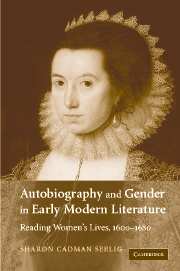Book contents
- Frontmatter
- Contents
- Preface
- Introduction: mapping the territory
- 1 Margaret Hoby: the stewardship of time
- 2 The construction of a life: the diaries of Anne Clifford
- 3 Pygmalion's image: the lives of Lucy Hutchinson
- 4 Ann Fanshawe: private historian
- 5 Romance and respectability: the autobiography of Anne Halkett
- 6 Margaret Cavendish: shy person to Blazing Empress
- Conclusion: “The Life of Me”
- Notes
- Bibliography
- Index
Conclusion: “The Life of Me”
Published online by Cambridge University Press: 22 September 2009
- Frontmatter
- Contents
- Preface
- Introduction: mapping the territory
- 1 Margaret Hoby: the stewardship of time
- 2 The construction of a life: the diaries of Anne Clifford
- 3 Pygmalion's image: the lives of Lucy Hutchinson
- 4 Ann Fanshawe: private historian
- 5 Romance and respectability: the autobiography of Anne Halkett
- 6 Margaret Cavendish: shy person to Blazing Empress
- Conclusion: “The Life of Me”
- Notes
- Bibliography
- Index
Summary
At the end it seems appropriate to return to some of the questions posed at the beginning, and to measure the distance we have traveled from the diary of Margaret Hoby to the Blazing World of Margaret Cavendish. I have focused on a sequence of representations of the self, from daily entries to more extended narratives, beginning in the life of the writer, in claims of factual representation, and moving toward more fully elaborated and persuasive accounts. Taken as a whole, these texts offer a view of the development of seventeenth-century women's writing and raise questions about our strategies for reading such texts.
In considering a variety of texts and their ways of recording and interpreting life experiences, I have tried to notice generic clues without imposing rigid expectations, but also to avoid taking generic differences for temperamental differences, aspects of function for matters of choice or expression (or failure of expression). Margaret Hoby's diary, for example, is plainly intended as an aid to her spiritual life rather than as mode of personal expression: a lack of emotion or personal detail in the text does not mean the absence of these things in life. Yet once we have made these adjustments, there is a good deal to be learned from such a sparse and limited text. There is, of course, information: through myriad details in the text the patient reader gets a fair idea of the scope and nature of Hoby's responsibilities and even of her recreations.
- Type
- Chapter
- Information
- Autobiography and Gender in Early Modern LiteratureReading Women's Lives, 1600–1680, pp. 154 - 159Publisher: Cambridge University PressPrint publication year: 2006



